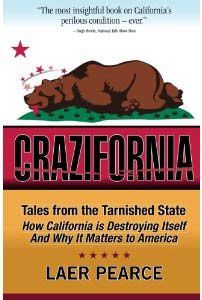It’s a tragedy! It’s a comedy! It’s Crazifornia!
By Wayne Lusvardi
In 2050, after California was hit with a 6.9 Richter scale earthquake on the Hayward Fault, the city of Vallejo didn’t suffer much because it already was a ghost town. California no longer had enough families to populate suburban Vallejo.
The Sacramento Delta, however, nearly instantly became an inland saltwater sea. Most of urban and agricultural California had lost its access to fresh water supplies overnight. California’s civilization hadn’t collapsed after all; it dissolved.
Democracy didn’t collapse, either. That is because democracy had already been replaced long before “the Little Big One” had destroyed much of the state’s water and transport infrastructure. Instead, unelected regional government committees that had merged cities and suburbs for tax sharing had supplanted it.
In the ruins, however, they found a book, “Crazifornia! Tales from the Tarnished State — How California is Destroying Itself and Why It Matters to America.” The author: Laer Pearce, a former war diplomat in the civil wars in California. The book had predicted the disaster that had just happened.
The above science fiction scenario is where author Laer Pearce takes you at the end of his prophetic book of tales of how California destroyed itself.
Like all classic literature, the book tells tales rather than boring with sophisticated public policy analysis, the dryness of a history book, or the escapism of a novel. Pearce’s stories are real life. Why write a novel when real life is more unbelievable than a novel? Pearce was involved as a participant in most of the tales he tells. He didn’t just read about them on the Internet.
What Crazifornia proves is Machiavelli’s dictum, “Nothing good occurs except by necessity.” And through some 15 decades of Progressive rule by both Democrats and Republicans in California there never had been any necessity to change.
I have worked in many capacities in several levels of California government. Pearce provides one of the most accurate descriptions of what ails California that I have ever read:
“A key factor in the demise of California is the state Legislature’s determination to dodge accountability for the negative effects its progressive actions have on the state’s residents and businesses. To do this, the Senate and Assembly have effectively turned California into a technocracy — a government ruled by educated elites who know what’s best for the people. It is these technocrats in the state’s many large and powerful regulatory agencies, commissions, and boards who actually impose the will of the Legislature through obtrusive and costly regulations and fines that were at best approved only in vague concept by California’s elected representatives.”
Progressive policies
Pearce describes how much of Progressive public policy is geared to take away choice from people and replace it with government mandates. But choice is what defines modernity.
As far back as 1893, California fought against the social change that came with modern society with the coming of the Southern Pacific Railroad. California’s counter-modernization has continued to this day with 16th-century energy technologies (windmills, solar energy mirrors), 19th-century modes of transit (light rail and the bullet train), dam removals and nuclear power plant building moratoriums and shut downs.
California has also embraced a de-modernizing worldview that rejects the Protestant work ethic and market capitalism for environmental ideology and social-movement unionism. It can only be called “crazy” for California to embrace “Progressivism” while wanting to go backward.
Pearce’s book is chock full of stories you likely never heard of. In Chapter 4 on California’s cultural revolution of the 1960’s Pearce describes how the C.I.A. program MKULTRA in San Francisco birthed the Hippie Movement. MKULTRA researched mind-altering drugs and two of its volunteer test subjects were Ken Kesey and Stuart Brand.
Kesey was the author of “One Flew Over the Cuckoo’s Nest” and Brand authored “The Whole Earth Catalog” — the manual of the Hippie Movement. It wasn’t hallucinogenic drugs that made “Crazifornia” crazy, however. It was Progressivism.
Jerry Brown’s blood money
In Chapter 3 on “Progressivism’s Legacy,” Pearce tells how Gov. Jerry Brown’s inherited wealth came from the blood-soaked Indonesian dictator Sukarno. Jerry’s father, former Gov. Pat Brown, brokered a loan for Indonesian junta generals to set up two oil trading firms. In return, Brown’s dad was given one of the trading firms.
Pearce writes that it was a lucrative deal because only Indonesian crude oil could meet California’s low-sulfur clean-air standards. It is implied that environmentalism serves as a pretense for elites to make mega-bucks from quasi-monopolistic enterprises. Only in “Crazifornia” could the greenest governor of any state have the political split personality of a closet oilman.
Pearce describes how the California’s “Brown-Shirt” unions tag team with environmental regulators to force businesses to unionize. One holdout company got inundated with 144 legal requests for data and another company got 143 data requests pursuant to a threatened lawsuit alleging non-compliance with environmental laws.
Another company that had relented to unionize received no such harassment or investigation from the California Energy Commission. In an event that could probably only occur in “Crazifornia,” the unions ended up brokering a settlement between the companies and environmental groups that the unions had funded.
Then there is the question that has to be asked: How did Pearce come up with the title “Crazifornia” for his book? Pearce says he was using the term on his old blog, “Cheat Seeking Missiles,” way before the book was written. But it was Pat Mulroy, the head of the Southern Nevada Water Authority, who perhaps validated Pearce’s characterization of California: “It’s hard being next to California. You’re so big, so powerful…and so crazy.”
Pearce was apparently a stand up comic in another life. He can’t help but dot his book with laughable stories such as how Brown was going to cut 3,000 jobs out of a state work force of over a quarter million bureaucrats. Pearce writes that this would be “like a small business with 10 employees, facing a prolonged recession and continuing massive losses, laying off one employee’s arm.” That’s becasuse, 3,000 employees comprise about 1 percent of the work force. But the state Legislative Analyst’s Office concluded that Caltrans was 15 percent overstaffed.
Read his book for the treasure trove of unforgettable stories you won’t find anywhere else.
The book deserves an Amazon.com five-star rating. It’s a quick, fun read. Buy it and hold on for a zany ride. But until the apocalypse, perhaps all you can do is laugh and then cry.
It’s a tragedy! It’s a comedy! It’s Crazifornia!
Related Articles
Sacramento aims to police the police
After a politically punishing year for law enforcement departments from Los Angeles to New York, California legislators are riding the wave of controversy,
The Gift After The Nunez Deal
Katy Grimes: Once again calling into question Governor Schwarzenegger’s strange agenda, today as part of his final hours in office,
CA “community solar” fight looms on subsidy issue
Hawaii’s boom in residential solar power is inspiring advocates of the alternative energy resource to push hard in states across





